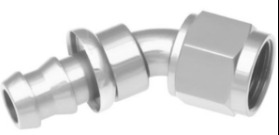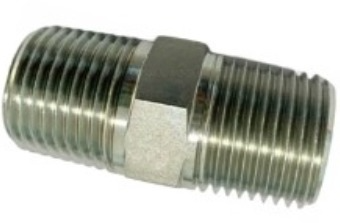Mastering transitions becomes an art in the intricate world of fluid systems. The AN to NPT Adapter Guide serves as your compass through the complexities of connectors. Let’s delve into the anatomy. We’ll cover the need for transition adapters.
We’ll discuss various types and material considerations. We’ll also talk about the art of selection. We’ll also look at installation techniques. Plus, we’ll discuss the advantages that make these adapters indispensable.
AN and NPT Explained
A. Anatomy of AN Fittings
45-degree AN push Lock Hose End
Construction and Design:
-
AN fittings, short for Army-Navy fittings, boast a sleek cylindrical design.
-
Precision-machined threads ensure a secure and leak-free connection.
Common Applications:
-
AN fittings find their forte in high-performance applications, from motorsports to aviation.
-
Commonly utilized in fuel, oil, and coolant systems due to their reliability.
B. Decoding NPT Fittings
Characteristics and Functionality:
-
NPT fittings employ a tapered thread design, sealing as they are tightened.
-
Their functionality makes them adept at handling high-pressure fluid systems.
Industry Relevance:
-
NPT fittings are prevalent in plumbing, hydraulics, and industrial settings.
-
Their standardized threads contribute to their widespread usage.
The Need for Transition Adapters
Size and Thread Variations:
-
AN and NPT threads vary in design and measurement standards.
-
Transition adapters act as the bridge, allowing seamless connections despite these differences.
Compatibility Challenges:
-
Mismatched sizes and thread types can hinder fluid system performance.
-
Transition adapters solve compatibility challenges, ensuring smooth transitions in complex systems.
Types of AN to NPT Adapters
A. Straight Adapters
Direct Transitions Explained:
-
Straight adapters provide a direct connection between AN and NPT threads.
-
Ideal for straightforward applications where a linear connection is needed.
Ideal Applications:
-
Commonly used in fuel and oil systems where a simple, direct connection is paramount.
-
Their simplicity makes them versatile for various fluid transfer scenarios.
B. Elbow Adapters
Navigating Angular Transitions:
-
Elbow adapters facilitate changes in direction, accommodating angular transitions.
-
Perfect for tight spaces where a straight connection is impractical.
Benefits in Tight Spaces:
-
Their curved design allows for flexibility in positioning within confined areas.
-
Commonly employed in engine bays and other areas where space is limited.
C. Tee Adapters
Branching Out with Triangular Connections:
-
Tee adapters provide a branching connection for fluid systems.
-
Triangular design allows for the diversion of fluid in multiple directions.
Common Uses:
-
Frequently used in applications requiring distribution of fluids to multiple components.
-
Found in complex plumbing systems and hydraulic setups.
Material Matters
A. Alloy Options
Stainless Steel:
-
Stainless steel AN to NPT adapters offer superior corrosion resistance.
-
Ideal for settings like maritime ones where endurance is crucial..
Aluminum Alloys:
-
Aluminum alloy adapters provide a lightweight yet robust alternative.
-
Commonly used in motorsports due to their balance of strength and weight.
B. Impact on Performance
Corrosion Resistance:
-
Material choice directly influences resistance to corrosion.
-
Proper selection ensures longevity, especially in harsh environments.
Temperature Tolerance:
-
Different alloys exhibit varying temperature tolerances.
-
Consideration of operating temperatures is crucial for optimal performance.
Selecting the Right Adapter
A. Sizing Considerations
Matching AN and NPT Sizes:
-
Matching sizes ensures a secure and leak-free connection.
-
Accurate measurement and selection are critical for a successful integration.
Avoiding Mismatch Issues:
-
Mismatched sizes can lead to leaks and compromised system performance.
-
Careful consideration of thread types and measurements is essential.
B. Application-Specific Choices
Motorsports and Automotive:
-
Motorsports often demand high-performance materials like stainless steel.
-
Automotive applications may benefit from lightweight aluminum alloys.
Industrial and Plumbing:
-
Industrial settings may require corrosion-resistant materials like stainless steel.
-
Plumbing applications may find cost-effective solutions in aluminum alloys.
Installation Techniques
A. Proper Thread Engagement
How to ensure secure connections?
-
Thorough engagement of threads is crucial for a leak-free connection.
-
Visual inspection ensures proper alignment before tightening.
Thread Sealant Application Tips:
-
Application of thread sealant enhances the seal between AN and NPT threads.
-
Choosing the right sealant for the specific fluid type is essential.
B. Torque Specifications
Guidelines for Tightening:
-
Adhering to recommended torque specifications prevents under-tightening.
-
Properly tightened connections ensure the structural integrity of the system.
Preventing Over-Tightening Pitfalls:
-
Over-tightening can damage threads and compromise the connection.
-
A balance between tightness and integrity is crucial to avoid potential issues.
Advantages of AN to NPT Adapters
Flexibility in Layouts:
-
AN to NPT adapters allow for creative and flexible fluid system layouts.
-
System designers can achieve optimal configurations for performance and aesthetics.
Enhancing System Efficiency:
-
Seamless transitions reduce resistance in fluid systems.
-
Enhanced efficiency leads to improved overall system performance.
FAQs
Can I use NPT on AN fittings?
-
NPT threads are not directly compatible with AN fittings. This is due to differences in design.
-
Transition adapters are necessary for secure and leak-free connections.
Are AN and NPT threads the same?
-
AN and NPT threads differ in design, measurement standards, and functionality.
-
Adapters act as intermediaries, allowing these distinct threads to work together.
Main Takeaways
Mastering the art of transitions with AN to NPT adapters requires a nuanced understanding of threads. It also requires knowledge of materials and installation techniques. These adapters bring harmony to the diverse threads they connect, ensuring a seamless transition. This leads to optimal performance.
Post time: Feb-14-2024



